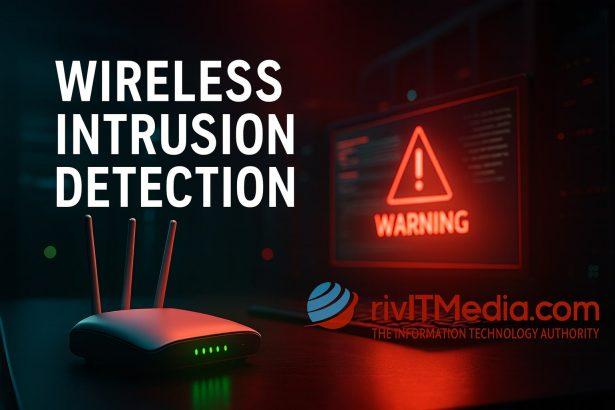A Wireless Intrusion Detection System (WIDS) is a network security solution that monitors radio frequency (RF) activity to detect unauthorized access points, rogue devices, and anomalous wireless traffic.
Its purpose is to safeguard an organization’s wireless infrastructure by identifying threats early and enabling timely incident response.
Unlike firewalls and antivirus software, which operate primarily at the wired or endpoint level, WIDS focuses exclusively on wireless-layer threats that can bypass perimeter defenses.
Protect Your Business’ Cybersecurity Now!
Protect your business from evolving cyber threats with our tailored cybersecurity solutions designed for companies of all sizes. From malware and phishing to ransomware protection, our multi-license packages ensure comprehensive security across all devices, keeping your sensitive data safe and your operations running smoothly. With advanced features like real-time threat monitoring, endpoint security, and secure data encryption, you can focus on growth while we handle your digital protection. **Request a free quote today** for affordable, scalable solutions and ensure your business stays secure and compliant. Don’t wait—get protected before threats strike!
Core Components of WIDS
A robust WIDS deployment typically includes three primary elements:
a. Wireless Sensors
- Function: Continuously scan RF channels for suspicious activity.
- Form Factor: May be integrated into existing access points or deployed as dedicated monitoring devices.
- Coverage: Strategic placement ensures detection across office floors, data centers, and perimeter areas.
b. Centralized Management Console
- Role: Aggregates sensor data, applies detection rules, and triggers alerts.
- Capabilities: Real-time dashboards, historical reporting, and policy enforcement monitoring.
c. Detection & Analysis Software
- Mechanism: Uses signature-based, anomaly-based, and policy-based detection techniques.
- Integration: Often linked with Security Information and Event Management (SIEM) systems for unified incident visibility.
Operational Mechanism
WIDS detects threats by listening to wireless traffic rather than participating in it. Key detection functions include:
- Unauthorized Access Point Detection: Identifies “rogue” APs connected to the corporate network without approval.
- Evil Twin Detection: Flags fraudulent APs mimicking legitimate SSIDs to steal credentials.
- MAC Address Spoofing Identification: Recognizes devices masking their hardware identity.
- Suspicious Traffic Analysis: Detects unusual volumes, unauthorized protocols, or patterns indicating exfiltration or attack attempts.
- Policy Violation Monitoring: Alerts when encryption standards (e.g., WPA3) are not enforced.
Business Relevance
Regulatory Compliance
Industries such as finance, healthcare, and retail must meet standards like PCI DSS, HIPAA, ISO/IEC 27001, and NIST 800-153, all of which recommend or require wireless monitoring.
Risk Reduction
- Mitigates Wireless Attack Vectors: Reduces exposure from drive-by hacking and insider threats.
- Improves Incident Response: Accelerates threat detection and forensic analysis.
Cost-Benefit Considerations
While WIDS implementation involves sensor deployment and licensing costs, the investment is typically outweighed by:
- Reduced breach probability and associated fines.
- Lower reputational damage from wireless compromise.
WIDS vs. WIPS
| Feature | WIDS (Detection) | WIPS (Prevention) |
|---|---|---|
| Primary Role | Monitors and alerts | Detects and blocks |
| Response Type | Passive (alert-based) | Active (automated countermeasures) |
| False Positive Risk | Lower | Higher (due to blocking actions) |
| Use Case | Compliance and visibility | High-security environments |
Many enterprise solutions now integrate both WIDS and WIPS capabilities, allowing configurable detection-only or active-prevention modes.
Implementation Considerations
Best Practices
- Comprehensive Coverage: Deploy sensors to eliminate blind spots, including lobbies, meeting rooms, and outdoor perimeters.
- Baseline Normal Traffic: Establish normal RF patterns to improve anomaly detection accuracy.
- Regular Rule Updates: Adapt detection logic to address emerging threats.
- Integration with SIEM: Ensure unified monitoring alongside wired network events.
Deployment Models
- Overlay WIDS: Dedicated sensors deployed alongside an existing wireless LAN.
- Integrated WIDS: Leveraging monitoring features in enterprise-grade Wi-Fi access points.
Security Stack Integration
Pair WIDS with endpoint protection, network firewalls, and SpyHunter’s multi-license anti-malware solution to ensure multi-layered defense.
Industry Examples & Trends
- Retail Chains: Use WIDS to detect rogue POS-connected APs that could compromise payment data.
- Healthcare Providers: Employ WIDS to monitor for unauthorized medical IoT devices.
- Financial Institutions: Integrate WIDS with threat intelligence feeds for advanced attack detection.
Emerging Trends:
- AI-Enhanced Detection: Machine learning models refining anomaly detection accuracy.
- Cloud-Based WIDS: Centralized management for geographically dispersed locations.
- IoT-Specific Monitoring: Targeted protection for wireless medical, industrial, and smart office devices.
Conclusion & Strategic Recommendations
Wireless networks are essential but inherently exposed beyond physical boundaries. A Wireless Intrusion Detection System offers businesses real-time visibility into their RF environment, helping prevent breaches, satisfy compliance, and maintain operational trust.
Strategic Recommendations:
- Evaluate current wireless security gaps and compliance requirements.
- Select a WIDS solution that integrates seamlessly with existing IT infrastructure.
- Consider hybrid WIDS/WIPS deployments for environments with high wireless risk exposure.
- Complement WIDS with endpoint and malware protection solutions, such as SpyHunter’s multi-license offering, to strengthen overall defenses.
Protect Your Business’ Cybersecurity Now!
Protect your business from evolving cyber threats with our tailored cybersecurity solutions designed for companies of all sizes. From malware and phishing to ransomware protection, our multi-license packages ensure comprehensive security across all devices, keeping your sensitive data safe and your operations running smoothly. With advanced features like real-time threat monitoring, endpoint security, and secure data encryption, you can focus on growth while we handle your digital protection. **Request a free quote today** for affordable, scalable solutions and ensure your business stays secure and compliant. Don’t wait—get protected before threats strike!




